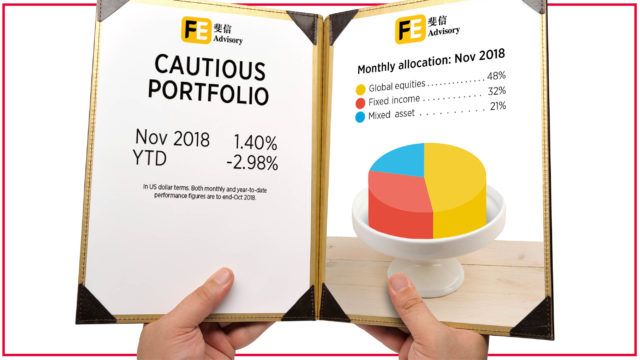Each month we feature the allocation in one of the three portfolios offered by FE Advisory Asia: Cautious, Balanced and Growth. Data is included to show how well the portfolio has done compared to the previous month and year-to-date so that readers can get a sense of performance.
Additionally, Luke Ng, senior VP of research at FE Advisory Asia, provides a concise analysis on macro events and their impact on the portfolio.

A breakdown of the Balanced portfolio at the end of November 2018*. Performance figures are in the menu image above.

Luke Ng, FE Advisory Asia
How did the market perform in November?
Following the carnage in October, markets recovered somewhat in November, but remained very volatile with wild swings seen from one day to the next. US markets performed well, supported by indications from the Fed that the pace of rate rises will not increase, although fears of a trade war persist. News from the Fed was particularly well received by emerging markets, which rallied on the more moderate stance and comfortably outperformed developed markets. Major oil importers such as India performed particularly well, thanks to falling crude prices in the month.
While falling oil prices benefited importers, the commodities-heavy FTSE 100 index suffered. The hit on UK equities was further exaggerated by continued uncertainty surrounding Brexit. The Eurozone continued to disappoint and produced a negative return. In Japan, a late rally in Japanese equities ensured they ended the month in positive territory.
As the Fed turned to more dovish language in November, the US 10-year treasury yield fell back to 2.99% by month end. Except for UK gilts, developed market sovereign bonds generally posted positive returns, whereas corporates, high yields and hard currency emerging market bonds fell into the negative boundary.
How did the Balanced portfolio perform?
The FE balanced portfolio gained 1.40% in November in US dollar terms. Boosted by the rebound in Asian markets, our China and Asia equity strategies were the best performing funds in the month. The latter benefiting from its overweight in India. After the hard hit in October, our Japanese equity holding through the JPMorgan Japan (Yen) Fund also recovered strongly and posted better returns than the respective market.
Meanwhile, our European exposure (including UK equities), which was acquired through our exposure to a Jupiter fund, suffered from the market weakness and ended up being the worst performing fund in the portfolio. Within our fixed income sleeve, apart from our short duration strategy which marginally fell in November, all our other exposures including Asian high yield managed to post a positive return.
How did you rebalance the Balanced portfolio?
We have maintained our conviction to slightly overweight the risk budget in our portfolio, despite the underlying equity exposure being slightly reduced. This has resulted from our decision to increase our exposure to riskier assets through both emerging market equities and fixed income due to their attractive valuations. By doing so, we have trimmed our exposure to developed market equities, especially in the US amid the positive push that we have seen from the US tax reform so far this year, but which will be fading away.
In addition, we have re-positioned our Asian exposure by exiting from the current equity and high yield bond strategies and re-positioned the residuals into Schroder Asian Asset Income – a strategy that adopts a flexible asset allocation in Asia, pursuing securities with attractive dividend payments or yields. This move allows us to stay focused in Asia and at the same time offer some protection against further possible macro headwinds in the short term.
FE Advisory Asia portfolio performance
| Jan 2018 | Feb 2018 | Mar 2018 | Apr 2018 | May 2018 | June 2018 | YTD* | |
| Cautious | 1.43% | -1.58% | -0.14% | 0.06% | 0.39% | -0.52% | 0.39% |
| Balanced | 3.64% | -2.68% | -0.18% | 0.44% | 1.22% | -0.96% | 0.75% |
| Growth | 5.19% | -3.60% | -1.17% | 0.63% | 1.75% | -1.22% | 1.36% |
| July 2018 | Aug 2018 | Sept 2018 | Oct 2018 | Nov 2018 | YTD** | ||
| Cautious | 0.65% | -0.17% | -0.43% | -2.47% | 1.15% | -1.30% | |
| Balanced | 1.99% | 1.12% | -0.59% | -6.67% | 1.40% | -2.98% | |
| Growth | 2.90% | 0.29% | -0.60% | -8.78% | 2.46% | -4.12% |

















